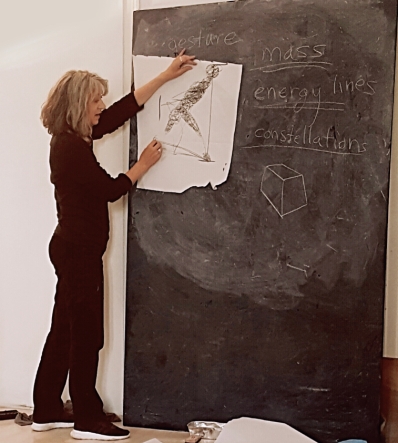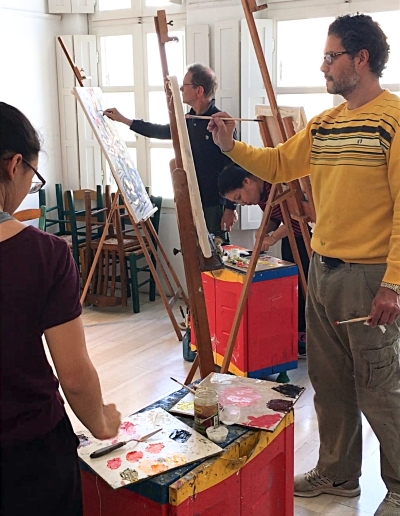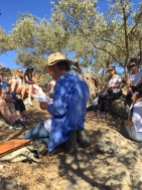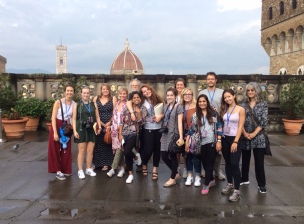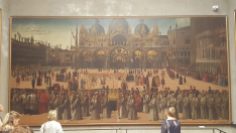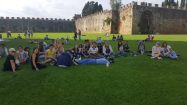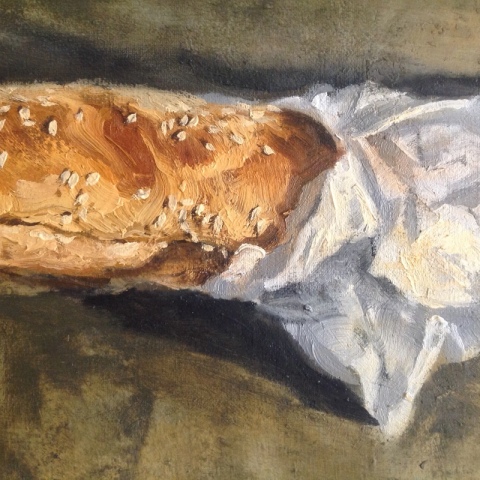Which Ancient Philosopher Are You?
31, December 2019 § 2 Comments
Epicureanism. Living gracefully within the garden of nature.
The Aegean Center students and staff spend a month each fall living and studying in the Villa Rospigloisi, in Pistoia, Italy. Besides classes in drawing and photography, we learn about Renaissance art and travel most days to see masterworks, returning with gratitude each evening to our villa in the hills. We often linger in the garden in the hours before dinner, watching the light play over the 400 year old magnolia trees, listening to the fountain splash and enjoying the aroma of food coming from the kitchen. We have few distractions, plenty of time to converse, and delicious home cooked meals. The combination of study and simple living create a joyous and rewarding month.
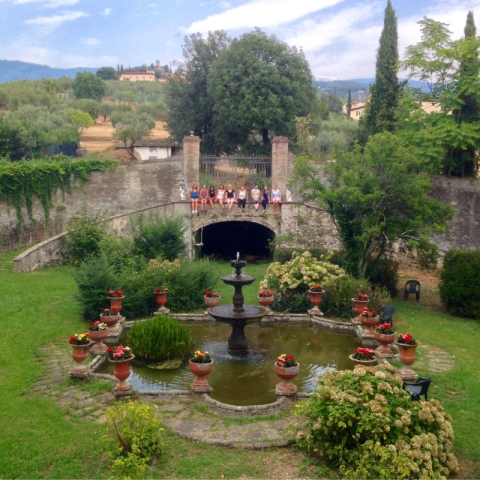 Our Villa Garden in Tuscany
Our Villa Garden in Tuscany
The fact that we are studying in Italy and Greece compels me to introduce a short conversation about ancient philosophers to my students. To make this interesting we read short synopses of seven different philosophies of the ancient world and see which of these resonates with their ideas of how to live a good life. Through a series of questions most of my students this term decided that they identified with Epicureanism. One student decided he was a nihilist, though that wasn’t on the list, and a few were drawn to Neoplatonism.
Epicurus was a 3rd BCE philosopher who believed that through elimination of fears and desires (ataraxia) people would be free to pursue simple pleasures to which they are naturally drawn. His followers were known as the Garden People and worked to banish superstition and cultivate a rational understanding of nature. Unlike many other philosophical discourses, women were allowed and urged to join his circle. Epicureans felt that discovering simple pleasures and living a prudent life leads to the greatest social happiness, that understanding the power of living within nature’s limits was essential. The word Epicureanism is misunderstood now as advocating hedonism but the philosopher himself said that a person can only be happy and free by living wisely, soberly, and morally. He said, “Nothing is enough for the man for whom enough is too little”. Our intention is to create an arts program with echos of this joyful search for individual happiness. We stress living with few material requirements, eating food prepared with pure ingredients and being in nature. We have no pretensions to luxury and yet we provide a wonderfully rich and fruitful atmosphere in which students can achieve their best . When simple wants are satisfied we have a deeper appreciation for the aesthetics aspects of life, of beauty, of art.
 Epicurus
Epicurus
In contrast to my students, I tend toward the Stoic philosophy. Again, modern understanding of this philosophy misinterprets Stoicism as merely censoring strong emotions. Marcus Aurelius and Epitectus elucidate the philosophy of Stoicism as a guide to find peace; integrity being the chief good. Epitectus said, ““Happiness and freedom begin with a clear understanding of one principle: Some things are within our control, and some things are not. It is only after you have faced up to this fundamental rule and learned to distinguish between what you can and can’t control that inner tranquility and outer effectiveness become possible.” What he believed was true education consists in recognizing that each individual has their own will and cannot be compelled or hindered by anything external. He felt that individuals are not responsible for the thoughts that arrive in their consciousnesses though they are completely responsible for the way in which they use them. “Two maxims,” Epictetus wrote, “we must ever bear in mind—that apart from the will there is nothing good or bad, and that we must not try to anticipate or to direct events, but merely to accept them with intelligence.”
 Filigree of Wildflowers on Paros
Filigree of Wildflowers on Paros
And, “Wisdom means understanding without any doubt that circumstances do not rise to meet our expectations. Events happen as they may. People behave as they will.” Finding that my ideals on how to live aligned best with the Stoics I also realised it aids my teaching; empowering me to honour each individual‘s place in the hierarchy of learning, reconfirming that competition has never been an effective teaching tool. I also recognise that what I say and what I teach will be taken by each student to mean what they interpret it to be and not always what I have said. Patience and being an attentive listener are paramount in a teacher but Stoicism also illustrates that 14 different students will have 14 different approaches to a given lesson. Each student will need specific help to elicit their best qualities. It’s not about meeting my standards as much as it is about their comprehension. And, of course, a teacher must accept that each group has its own personality. Fortunately in this group, they were mostly Epicureans by nature.
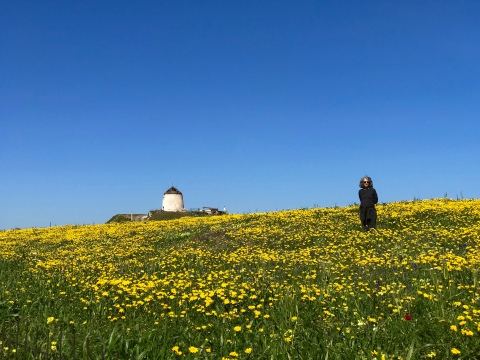 Yellow & Blue Paros Spring
Yellow & Blue Paros Spring
Raphael & 北斎
15, August 2017 § Leave a comment
Raphael’s Drawings: at the Ashmolean & Hokusai: Beyond the Great Wave
At the end of the session this last spring John and I traveled to England to spend a few days in Oxford. We went to see a show of Raphael’s drawings at the Ashmolean, a collection of over hundred and twenty of his original works of art. Drawing exhibitions are far and few between and I was particularly anxious to see this one because Raphael’s draftsmanship is extraordinary and difficult to find and see in person.
It has been said that drawing, within the visual arts, holds the position of being closest to pure thought. (Elderfield) In this sense the drawings allow us to see inside Raphael’s mind as he composed images which would evolve into paintings, frescoes and tapestries. His exploratory line and his imaginative thought process are clearly on view in these works. You feel him working through ideas, expressing emotion with a variety of poses and exploring specific narratives. His drawings are derived from models, imagination, and sometimes from memory. What struck me most was the delicacy and fineness of his workmanship, the exquisite details and the accuracy of his line, his potent understanding of how light describes form. I learned that he often used a stylus to sketch out the preliminary form on the paper before beginning the drawing. This was called a blind line because it did not leave a mark. The drawing was then refined with either metal-point, red chalk, or charcoal. Exploring the spiraling tensions and revealing a staggering knowledge of anatomy he amplified the composition with interlocking negative space and groupings of figures. He was able to reveal the emotional quality of the figures with a minimum of information, sometimes showing only the back of a head or a gesture of the hand to communicate the mood. With rhythm, geometry, and poetry of line his drawings become a testament to the human form as an expression of life force.
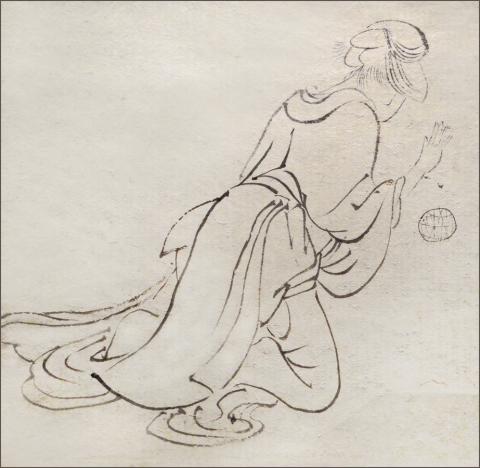
On the way back to Athens we stopped in London and were lucky enough to see the exhibition “Hokusai: Beyond the Great Wave” at the British Museum. This artist’s encyclopedic knowledge of nature is on show with many drawings done with ink and brush, woodblock and illustrated books. Again I was struck by the detail and careful renderings, the delicacy of his work. I think it was Ruskin who said that in fine art there must be something “fine” and I thought once again, looking at Hokusai, that perhaps this is something we’re missing in much of contemporary art. It seems that the muscular, the shocking and the mundane have more value to us than careful observation and recording of form which is so lovingly revealed in these masterworks. Although the artists lived two and a half centuries apart and on two different continents, although they depict two different cultures, there are common elements to their work. Both artists express the inexpressible through the twisting forms of human anatomy, pushing to discover at some level our common humanity and our extraordinary capacity to endure. Meticulous, patient observation combined with imagination and the desire to reveal truth is the binding principle that brings these two artists forward into our world with enduring quality.
Jane Morris Pack

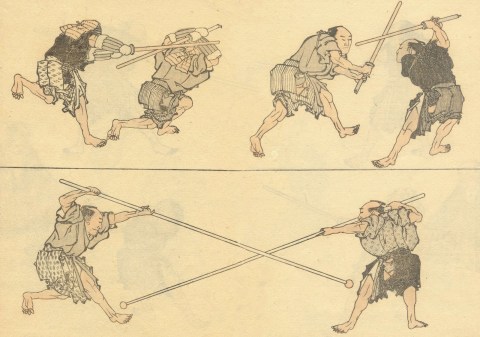


Εγκύκλιο Παιδεία • Liberal Arts
3, February 2017 § 2 Comments
“When we ask about the relationship of a liberal education to citizenship, we are asking a question with a long history in the Western philosophical tradition. We are drawing on Socrates’ concept of ‘the examined life,’ on Aristotle’s notions of reflective citizenship, and above all on Greek and Roman Stoic notions of an education that is ‘liberal’ in that it liberates the mind from bondage of habit and custom, producing people who can function with sensitivity and alertness as citizens of the whole world.” –Martha Nussbaum, Cultivating Humanity: A Classical Defense of Reform in Liberal Education, 1998
 Seven Liberal Arts: Francesco Pesellino: 1422-1457 Florence
Seven Liberal Arts: Francesco Pesellino: 1422-1457 Florence
While hoping to find a way to take a much needed sabbatical many years ago I made some phone calls in search for a person to take over my job for a semester. I talked to a woman who taught at a well known academy in the States, someone who I felt could teach drawing and painting simultaneously as I had been doing for years at the Aegean Center. I gave her the outline of the program; a three month course, in Greece, teaching 20 hours a week, covering the gamut from printmaking to oil painting. She brushed aside my inquiry but not because she felt the weight of long hours of teaching, or because the responsibilities were onerous, but because she would need to teach drawing and painting concurrently. She said that a student needed a full year of basic drawing, followed by a full year of figure drawing before they should be allowed to touch a brush. When I explained that being a single semester abroad program prevented us from spreading out the curriculum in this way she dumbfounded me with her response. “Well”‘ she said, “I consider myself a fascist when it comes to art instruction”. I thanked her for her time and promptly hung up.
In relating this story to students I often wondered whether the fascist intent was sanctioned by her academy or if it was just her own perverse mindset. I have unfortunately seen and heard of teachers who felt their method was uniquely correct and had no tolerance for other viewpoints. In art classes the slavish adherence to what is fashionable and a blindness to tradition can narrow students responses. As teachers we must all ensure that our students learn the basic skills that will serve them in future no matter which direction the art world takes. I am deeply committed to obtaining and practicing these skills, but to be a self proclaimed fascist in order to attain that objective is repugnant. Recently I contemplated her response again and thought about it in context to the current political climate. It still horrifies me and I still fight against the dictates that her statement implies.
The Liberal Arts were conceived to educate citizens who could uphold the highest ideals of the Greek and Roman cultures. Rhetoric, grammar, logic comprised the trivium and to these were added the quadrivium of arithmetic, geometry, music and astronomy. Over the course of the centuries a liberal arts education has come to means something broader but it still indicates a course of study which seeks to inculcate a student to uphold the fundamental underpinning of a democratic society. The arts, especially the visual arts, play a role in embedding memory, culture and history into the minds of citizens. The museum plays its part as well as the galleries, publications and criticism. The arts aspire to imagination, forward thinking, to uphold aesthetic ideals and keep sensitivity alert. This perhaps is why the first thing many dictators do is imprison the artists and poets. But art can also be fashioned into propaganda and can in itself become weighted down with rules and dictates. And apparently teaching art can become fascistic as well.
If we are to remain an open society we need to teach the creative process and embody it as well in our teaching. I try to foster a creative environment in the studio along with emphasizing the discipline that learning an art form demands. Strangely, many art students do not feel creative. The striving to make something of merit often stifles the urge to begin. Creativity requires a certain amount of mess, of boredom, of play and practice in order to perform its magical alchemy. Rigid hierarchical formulae do not help to promote its appearance. We cannot be creative if we are being taught that conforming is the most important requirement. This is why so many students feel that being creative is a rare gift rather than a natural outcome of their nature, too many years spent in graded, monitored, tested classrooms can kill off the ability to create. Often beginning students are intensely creative before fear and compliance knock them back into simply performing for others.
I stay in my job with pleasure, it keeps me involved in my passions and engaged with young clever minds. I teach drawing and painting but I also feel my job is to awaken students to their own nascent creativity. To engage in the creative process is to grow as a person and as a citizen of the world. Within the beautiful environment of the Center with its multicultural milieu, with imaginative and intellectual activities and trusting relationships the creative is allowed to emerge. :Jane Morris Pack
“Those persons, whom nature has endowed with genius and virtue, should be rendered by liberal education worthy to receive, and able to guard the sacred deposit of the rights and liberties of their fellow citizens; and . . . they should be called to that charge without regard to wealth, birth or other accidental condition or circumstance.” –Thomas Jefferson, 1779
Half Way
29, October 2016 § Leave a comment
 Clearing Storm at the end of a brilliant day
Clearing Storm at the end of a brilliant day
As the last days of October come in with clouds and cold winds, we have arrived at our half term break. Some of the students will be travelling, but the majority of the group are choosing to stay in Paros to work in the studios and the digital lab. It has been a busy and event filled semester. After returning from Italy we introduced the landscape of our lovely island with several hikes, the first was a walk above Lefkes to the inner valley beyond the windmills. There among the olive trees John read an entry from his journal from the time he lived on the Navajo Reservation in Arizona. It never fails to move his audience and this time there was a deep quiet as he finished. His words touched us all.
 John reading from his journal under the olive trees
John reading from his journal under the olive trees
Last weekend we sailed around Antiparos with Captain Tasso and had a meal at Zombos, a restaurant at the southern end of the island facing Despotico. We had just strolled about the new excavations of the ancient temple, getting a glimpse into the working of the restorers who are rebuilding the facade of the temple. The winds came up as we finished our meal and Captain Tasso felt we needed to start back to avoid the oncoming storm. It caught up with us anyway and we all got wet, but the students sang and huddle together and we were rewarded with a full rainbow as we turned the corner toward Paros and home.
A few days ago Dimitra Skandalis gave a guest lecture on her work just before she returned to her new home in San Francisco. She shared her ideas and her passions with students and brought along some samples of the work she does with seaweed. She is a former student who is originally from Paros. Her exhibition at the school this summer was her first solo show here on the island.
Now with a much needed break to consolidate information and clarify goals, the students will come back to finish the semester work and prepare to display their efforts for the final exhibition in the first week of December.
 Cliffs of volcanic detritus on the backside of Antiparos.
Cliffs of volcanic detritus on the backside of Antiparos.
 Enjoying the Rain…Hoddies!
Enjoying the Rain…Hoddies!
:Thanks, Ken Shiozawa, for the photos and being Student Extraordinaire
Tour Through Italy and Return to Greece
10, October 2016 § 2 Comments
By: Jun-Pierre Shiozawa
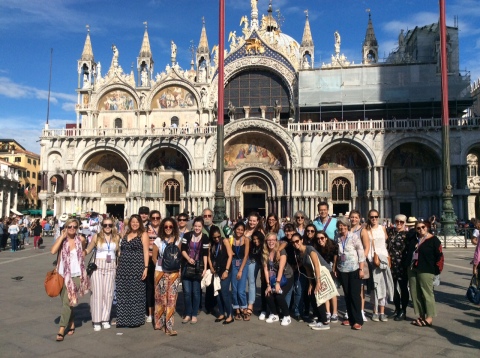
The Aegean Center in front of the Basilica of San Marco, Venice
The past month the Aegean Center for the Fine Arts marked the 28th year of its Italy program. The new group of students arrived in early September at the Villa Rospigliosi, the Aegean Center’s home in Italy. Up in the hills overlooking the Tuscan city of Pistoia, the students became accustomed to life at the Villa; classes throughout the day including drawing, photography, writing and theatre, and sharing prepared meals by the Villa chefs, who have been with the Center since the very first years.
The bulk of the Italy program involves touring the great centers of the Italian Renaissance, including Florence, Siena, Venice, Pisa, Pistoia, Rome and for the first time ever for the Aegean Center, Bologna.
In Florence, the Center was able to visit the newly reopened Museum of the Works of the Duomo featuring a new layout which recreates the facade of the Cathedral with original sculptures set in niches. We toured through the great churches and museums of Florence including the Bargello and the Uffizi. As always, the Brancacci Chapel in the church of Santa Maria del Carmine was a highlight of the tours in Florence. Inside the chapel the group was able to enjoy thirty minutes to themselves to study and admire the great fresco masterpieces of Massacio and Masolino.
On one rainy day, our bus brought us through the Tuscan hills to Siena, where we were fortunately greeted with clearer skies and sunshine. The Cathedral of Siena was less crowded than usual and we were able to admire its incredible array of sculpture and decor, its fascinating floors and the colorful Piccolimini library.
During our second week in Italy, the Aegean Center visited Venice for three days. Upon arriving, art history professor Jeffrey Carson led the tour through the Piazza San Marco and up in to the Basilica of San Marco to see the original bronze horses, taken from the hippodrome of Constantinople. The next day the Aegean Center toured the great painting museum of Venice, the Accademia and found some of our old favorites, works by Giovanni Bellini, Giorgione, and Titian.
After returning to Venice we continued our tours through Tuscany with a visit to Pisa where we enjoyed a bright sunny day in the “Piazza dei Mirocoli,” (the Plaza of Miracles) with its beautiful marble faced buildings: the Cathedral of Pisa, its baptistery, the Campo Santo and of course, the Leaning Tower. In the baptistery, Studio Arts professor Jane Pack described the innovative work of Nicola Pisano’s pulpit and we were able to hear the incredible acoustics of the baptistery interior as one of the guards made a call in to its dome which echoed with his own response.
The Aegean Center visited Bologna for the first time as well. The home of the oldest university in the world, Bologna welcomed us in its rich array of historical and religious centers, including the Basilicas of San Petronio and San Domenico. Although we were unable to see Giambologna’s Fountain of Neptune (under restoration) and Raphael’s Ectasy of St. Cecilia (currently on loan for the Pushkin Museum’s “Raphael. The Poetry of the Image” exhibition) we were taken by the austere beauty of the medieval and premedieval church complex of Santo Stefano and the energy of the city itself.
The Aegean Center students enjoyed our last meal at the Villa Rospigiliosi and thanked the Villa chefs with a thank you card and applause. Saying farewell to the Villa is always bittersweet, a mixture of sadness and excited anticipation with what lays ahead: Rome and finally Greece!
In Rome, director John Pack led the students through a winding tour of Rome’s downtown. John took the students through its famous piazzas, complete with stops for Granita di Cafe in front of the Pantheon and a trip up the Capitoline hill to view over the ancient Roman forum. The next day Jane led the group through the magical Palazzo Massimo to see its treasures including the bronze Pugilist, the dying Niobid and the lovely garden frescoes from the Villa Livia. Finally on our last day in Rome the Aegean Center woke up at the crack of dawn to visit the Vatican museum and where we had the Sistine Chapel all to ourselves, entering before any other group. We all gasped at Michelangelo’s achievements, awestruck and moved.
Rome marked the final leg of the Aegean Center’s Italian tour and the students then departed for Athens. There, under the characteristically bright Greek sunlight, art history Jeffrey Carson led the students up to the Acropolis to see the monument to the magnificence of the Ancient Athenians: The Parthenon. That night, one of the students, Aria Higgins, invited the entire Aegean Center to dine at her family restaurant, Mama Roux. The last day of touring before the students’ arrival in Paros was at the greatest museum of ancient Greek antiquities in the world, the National Archaeological Museum of Athens.
Now the students have all arrived in Paros, to settle in and prepare for the classes ahead. We are all excited to see what else will be accomplished with this close knit, energetic and talented group of students.

Sunrise over the Aegean Sea from the ferry en route to Paros
Thank you very much to Bruno-Ken Shiozawa for the use of his photographs for this post
Drawing and Theatre
8, June 2016 § Leave a comment
By Jane Pack

Annelise teaches theatre at the Aegean Center and I teach figure drawing. This last semester she was taking my class and I was taking hers. We often heard our words to students echoing each other, she commented that I sounded like a theatre teacher and I frequently wanted to break in on her classes and exclaim, “The same applies to drawing!” Of course the arts are grouped for a reason, as creative endeavours each challenges the practitioner to move out of their comfort zone, to search for meaning, to communicate feeling. But drawing and acting seem to have a particular resonance with each other, similar vocabulary can be useful in each: gesture, rhythm, movement, weight, form, vision. And each requires intense concentration, a challenge to refresh and renew our approach each time, a thoughtful and deep presence. It has been said that drawing, of all the visual arts, is closest to pure thought. And acting has that same intensity, the need to be in continual focus or risk losing it all.
I urge students to challenge themselves to use new approaches for each drawing, to keep themselves from being bored with their own accomplishments. I teach craft and expression side by side, but push technique so that the students can think emotionally and still be outside those feelings enough to communicate them. In theatre one loses oneself in a role only when the self steps aside and allows the dramatic impulse of the playwright to come through. I found I was thinking almost like a draughtsman when I was crafting my role: what shape, what form, what movement, what rhythm. And the actress, Annelise, considering how a drawn gesture communicates tension, where the human form expresses emotion, what the speed of the line or its weight can do to change the depiction.
Each discipline has its magical storytelling moments, each includes the element of audience although that is profoundly more weighted in a performance on stage. Still, the draughtsman is performing too, the moment the pencil encounters the page. Most importantly, with practice and discipline, each art brings us closer to our unique self and wakes us up to the present.
THRESHING: PHOTOGRAPHY IN PRAISE OF SLOW ART
11, April 2016 § 1 Comment
In the past I have written brief blog posts when Slow Art Day came around. April 9th is here again, and by chance I have been discussing slow art in my Saturday morning classes.
Usually I illustrate my points with a famous photograph, but this time I have chosen one of my own photographs, which was on display at the Parian Farmers’ Union Visitor Center for several years.

It is part of an extended sequence called Heroes of the Soil, in which I attempted several things. One was to record the old techniques and traditions of farming which, though not obvious to the casual glance, were still being practiced by some farmers old and young. Another was to honor them and their appreciation of their own skills and their respect for them.
In this photograph a farmer and his four mules are threshing wheat on a hilltop several kilometers from Paroikia. The farmers knew I was doing this work and approved of it, and frequently called me to alert me to be ready, as here.
In making slow art, first decide on your subject matter, then carefully observe the scene and decide what time of day the light would be most suitable to capture the essence. This picture was taken in late morning when the sun was nearly overhead. The composition I envisaged contained both very dark and very light material. So I had to decide which to emphasize. Next, if the scene contains elements in motion, carefully study them, since repetitive patterns will prove useful to you. And of course shutter speed depends on how fast or slow they move. All this requires time and patience and respect for your subjects.
Now you must decide on the correct angle of view. In this photograph, in order to emphasize the heroic quality which is basic to the whole sequence, I chose a sufficiently low angle of view so that the figures would break the horizon line.
The threshers are, I trust, honored by the finished image. When I was photographing, they were working with me, but in the darkroom, needless to say, I was alone.
By Liz Carson
Clean Monday / Καθαρά Δευτέρα
14, March 2016 § 1 Comment
Clean Monday, Καθαρά Δευτέρα, is celebrated today here in Greece. It is the first day of Lent when the faithful begin 40 days of fasting in preparation for Easter.
Traditional foods are served which emphasis austerity and deprivation to echo the fasting of Christ in the desert. In Paros the devout eat pickles, food without oil, and animal flesh only without blood such as kalimari and octopus. Eggs, dairy and meat are absent from the table. These rules make sense for an agricultural society which must protect the brooding chickens and the young goats and cows so as to assure the next generation. There will be kite flying and family picnics if the weather is good, being out of doors allows us to witness a burgeoning spring with the world returning to abundance and production after the winter’s hush. Here on the island we have a winter that is most gentle and verdant, the deprivations others face with cold and snow are less known to us. We watch the re-emergence of new leaves on the deciduous trees resembling butterflies emerging from their chrysalis. We observe the prancing young goats and lambs. We contemplate the new growth which is all around making us aware of the cycles of nature, potent harbingers of life and rebirth.

“Lagana / Λαγάνα” the special azyme bread baked only on Clean Monday.
Greeks are asked to give up luxuries during this time. Many people no longer conform to the strict diets but I feel there is something important about denying ourselves our indulgences. We grow accustomed to having far more than is necessary for our existence. Every year I try to find something which I think I need but which is not essential to my survival and give it up for 40 days. I have denied myself at various times chocolate, coffee, wine and sweets. None of these posed a particular problem for me. Far more difficult was the challenge to give up complaining which I did not manage. This year I have decided to quit looking at the daily news feed in the mornings. I find it wastes at least one to two hours of time that I would otherwise fill with more imaginative pursuits. Beginning every morning with the anxious headlines is addictive but not ultimately uplifting or productive. Perhaps I will simply sit with my coffee and dream, with luck I will begin a creative project. And so my yearly fast begins.
Solvent Free Painting
22, May 2015 § 2 Comments
by Jane Morris Pack
We admire masterworks in museums for, among other things, their brilliant colouring, their longevity due to the painter’s technical expertise and for the evidence of the artist’s hand in the brushwork. Many paint effects from the past seem nearly unattainable with modern materials and this has lead artists to try to rediscover secret formulas or find additives that emulate historical processes. Resins, wax, and complex chemical mixtures have all been tried. Research done by the National Gallery in London however has revealed that linseed oil, coloured pigment and additions of calcium carbonate are the sole ingredients in many master works before the 20th century.
Though we are seduced by the ubiquitous presence of modern materials, traditional methods are intriguing and wonderful to investigate. Egg tempera and encaustic have both had a renaissance in the last twenty years. The fundamental substance of oil painting however, which is the oil itself, has been accepted as standard by most artists. Modern linseed oil is alkali cleaned and heated, it is no longer manually pressed and sun thickened as it was. Some artists with curious minds have now reexamined the refining of the flax oil. Louis Velasquez and Tad Spurgeon both have websites dedicated to methods of hand refining oil to produce a non yellowing, flexible, fast drying oil which completely transforms the painting process. What they have uncovered in their investigations is a remarkable way to access an old and very successful formula.
My involvement in this exciting investigation began when I assigned Velazquez, the 17th century painter, as the topic of my advanced painters seminar. We looked into the addition of marble dust, a form of calcium carbonate, to his paint. I stumbled on the information about hand refining oils then but felt it was too intensive to delve into at the time. It took me several more years and further seminars on Rubens and Vermeer before I took the plunge and followed procedures I had read about online. The results are quite amazing to me, and the difference from the handling of modern tube oils is significant. The hand refined oil makes many things possible which I had read about and seen but had not been able to obtain. I always felt tube oils were too slippery, too thin, too flat once dry. I also found the suede effect annoying and could not build up impasto areas without needing many days of drying time. The hand refined oil has none of these defects.
This semester I introduced the new oil to students and we worked together to understand its potential. It is more flexible, shinier and forms a tougher film than the tube oils. The viscosity of the paint allows one to paint wet into wet without loosing brushstroke integrity and colour purity. It is far more transparent, the glazes are deep and clean, and it dries evenly and quickly without darkening as much. Impasto areas can dry overnight, depending on the weather, and keep their sharp edges and texture.
The best part of all of this is that solvent has been banished from the studio. We clean our brushes in vegetable oil and never thin paint with solvent. The smell of the new oil is something like fresh grass or fields of flowers. Because we mix it 1:3 with chalk and then use that 2:1 with tube paint our paint supply goes much further. It is hard on brushes though, as they wear down quickly. One wonderful advantage is the ability to wipe off the paint completely from a dry underlayer making changes in plan easy to execute.
There has been a complete change in my approach to paint and the student work is richer and more colourful. We are able to work into surfaces more quickly which speeds our process. The studios are no longer redolent with turpentine and the improved environment is beneficial for all who share our space.


